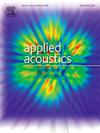Exploiting lightweight neural post-filtering for directional speech enhancement
IF 3.4
2区 物理与天体物理
Q1 ACOUSTICS
引用次数: 0
Abstract
Directional speech enhancement using a microphone array aims to isolate the target speaker's voice from competing speakers and background noise. While traditional signal processing-based beamformers often struggle to suppress residual interference, end-to-end methods face challenges in operating on low-resource devices and generalizing to real-world scenarios. To address these issues, we propose a hybrid approach that integrates the robust generalized sidelobe canceler (GSC) with a neural post-filter. Our method employs a lightweight network architecture as the backbone of the neural post-filter, utilizing both microphone array signals and GSC outputs, which are modeled by separate encoders. Additionally, we introduce an auxiliary decoder to learn the target components in the GSC outputs, thereby enhancing the post-filter's performance when combined with a knowledge distillation training strategy, all without introducing additional computational load during inference. Experimental results on simulated and real-world datasets demonstrate the superior performance of the hybrid system, validating the effectiveness of our proposed methods.
利用轻量级神经后滤波进行定向语音增强
使用麦克风阵列的定向语音增强旨在将目标说话者的声音与竞争说话者和背景噪声隔离开来。传统的基于信号处理的波束形成器通常难以抑制残余干扰,而端到端方法在低资源设备上运行和推广到现实场景时面临挑战。为了解决这些问题,我们提出了一种将鲁棒广义旁瓣对消器(GSC)与神经后滤波器相结合的混合方法。我们的方法采用轻量级网络架构作为神经后滤波器的主干,利用麦克风阵列信号和GSC输出,它们由单独的编码器建模。此外,我们引入了一个辅助解码器来学习GSC输出中的目标分量,从而在与知识蒸馏训练策略相结合时增强后滤波器的性能,而不会在推理过程中引入额外的计算负荷。在仿真和实际数据集上的实验结果证明了混合系统的优越性能,验证了我们所提出方法的有效性。
本文章由计算机程序翻译,如有差异,请以英文原文为准。
求助全文
约1分钟内获得全文
求助全文
来源期刊

Applied Acoustics
物理-声学
CiteScore
7.40
自引率
11.80%
发文量
618
审稿时长
7.5 months
期刊介绍:
Since its launch in 1968, Applied Acoustics has been publishing high quality research papers providing state-of-the-art coverage of research findings for engineers and scientists involved in applications of acoustics in the widest sense.
Applied Acoustics looks not only at recent developments in the understanding of acoustics but also at ways of exploiting that understanding. The Journal aims to encourage the exchange of practical experience through publication and in so doing creates a fund of technological information that can be used for solving related problems. The presentation of information in graphical or tabular form is especially encouraged. If a report of a mathematical development is a necessary part of a paper it is important to ensure that it is there only as an integral part of a practical solution to a problem and is supported by data. Applied Acoustics encourages the exchange of practical experience in the following ways: • Complete Papers • Short Technical Notes • Review Articles; and thereby provides a wealth of technological information that can be used to solve related problems.
Manuscripts that address all fields of applications of acoustics ranging from medicine and NDT to the environment and buildings are welcome.
 求助内容:
求助内容: 应助结果提醒方式:
应助结果提醒方式:


